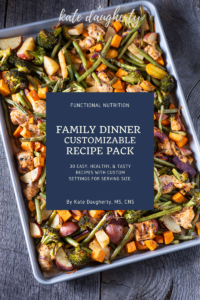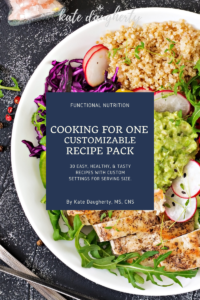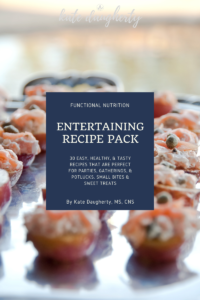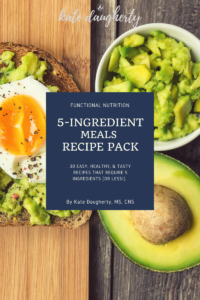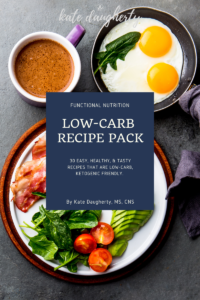
The Lifestyle Habits You Need for Healthy Hormone Balance
Lifestyle habits are a huge component of healthy hormone balance. We live in a go-go-go time where we forget to honor ourselves. When we have poor stress-management, lack of movement, and a toxic environment it’s a recipe for hormone imbalance; manifesting as skipped periods, infertility, mood dysregulation, and general malaise. The five areas I look at that fall into ‘lifestyle’ include your diet, your exercise routine, your self-care, your sleep, and your environment. Poor performance in any of these areas can contribute to hormone issues that manifest as physical symptoms. Here are 5 categories of lifestyle habits for healthy hormone balance. 1 – Diet Your diet has a major impact on hormones. Start by eliminating any suspected food sensitivities or food allergies. If you’re not sure how to do that on your own, check out my Elimination Diet Guide. Next, start to evaluate the overall nutrient density of your diet. Choose real, whole foods. Eat plenty of high-quality protein, fats, and fiber. Do your best to ‘eat the rainbow’ daily to cover an array of phytonutrients. Incorporate Hormone-Healing foods like seeds, oysters, leafy vegetables, and legumes. Even when your nutrition is on-point, it may be useful to supplement with certain vitamins that are difficult to obtain from our diet. Things like Vitamin D, Magnesium, and Folate can fall in this category. Learn more about my top recommended supplements here. Lastly, make sure you stay hydrated! Aim to consume half your body weight in ounces or more, and drink to thirst. 2 – Movement Do your best to make movement a priority in and out of the gym. A successful exercise routine is any activity that you enjoy doing! This could be yoga, HIIT training, rowing, swimming, weight-lifting, or hiking. Don’t be afraid to change things up. There’s big power in listening to your cycle and adjusting workouts depending on how you’re feeling (a concept known as Cycle Syncing). A good start is adding movement after meals. Even a short, brisk walk can support cortisol and insulin balance. These hormones are tightly regulated by the liver and adrenal glands. Cortisol and Insulin are both involved in the endocrine system and will have downstream effects on sex hormones. Use your in-the-gym time to focus on resistance training. Even if it is just bodyweight resistance, this is important to increase/maintain muscle mass and support bone health. The more muscle you can build and preserve, the ‘hotter’ your metabolism will run. 3 – Stress Management / Self-Care Re-engage with yourself. Strive for balance, but recognize the natural cyclical changes that hormones bring. Get in tune with when you are at your highest energy (typically at ovulation) and when you need a slowdown (before menstruation). By leaning into your natural rhythm, you’ll be less frustrated when you do feel emotional. Find a regular self-care routine. This could include breathing exercises, meditation, journaling, yoga, time outside, prayer, art, or anything else that brings you joy. Not sure where to start? Kristen Milliron, LCSW, shares her tips for starting a journaling practice here. You may never have a ‘stress-free’ life… but how you manage your stress makes a difference. Also in the self-care realm: finding a way to connect with yourself (or your partner) is essential for hormone health. Oxytocin, the hormone of connection, is released during orgasm, breastfeeding, as well as massage, holding hands, and hugs. Sexual intimacy is not just important for trying to conceive, but also helps to regulate your menstrual cycle and improve moods. 4 – Sleep Get in bed. You likely need 7-8 hours of quality sleep to feel your best. Make this a habit by setting a bedtime alarm that says, “hey, time to get IN bed” in addition to your usual morning alarm. If you can establish a regular routine, your body will adjust. Optimize your sleep environment. Turn off screens a few hours before bed, wear blue blocking glasses, sleep in a dark room, and perfect your evening routine. The better control you take over these manageable habits- the better quality sleep you will achieve. Ask for help. If you find yourself waking at regular intervals through the night, unable to fall asleep, dealing with negative thought patterns, or having physical symptoms preventing good sleep (night sweats, restless legs).. ask for help. A Mental Health Therapist, Functional Medicine Doctor, or Nutritionist can evaluate your symptoms and offer intervention. 5 – Environment A big part of Healthy Hormones lies in making an effort to decrease your toxic burden. We live in an increasingly toxic world and it seems to be closing in on us. Our personal care products, makeup, cleaning products, and food storage likely contain harmful chemicals that CAN be avoided. Do a deep dive of your environment by considering these questions: Do you buy organic food and/or avoid the Dirty Dozen? Do you use glass/stainless steel for food storage and avoid plastics? Do you drink filtered water? Do you buy pharmaceutical grade supplements? Do you use clean makeup and skincare products? We can best support detoxification in the liver by staying hydrated, pooping daily, and consuming adequate protein & fiber. ((Learn more about detox here)) Related: Dietary Fiber: Understanding Soluble vs Insoluble Fiber Changing Lifestyle Habits for Healthy Hormone Balance takes time. These habits are things to slowly adopt to get you more in tune with yourself. One day at a time. Free Managing Stress & Anxiety Cookbook: Want 20 recipes to manage stress & anxiety? Click here to get Kate’s Stress&Anxiety Cookbook that includes recipes that supply adequate magnesium, B6, iron, and fiber! Want to work with a functional nutritionist to personalize your diet? Struggling with hormone imbalance, IBS, weight gain, mood changes? Let’s look at FOOD FIRST. Read more about Functional Nutrition at The Facility here. CLICK HERE to schedule a FREE 15-Minute Nutrition Consult with Kate to determine your best course of action!






